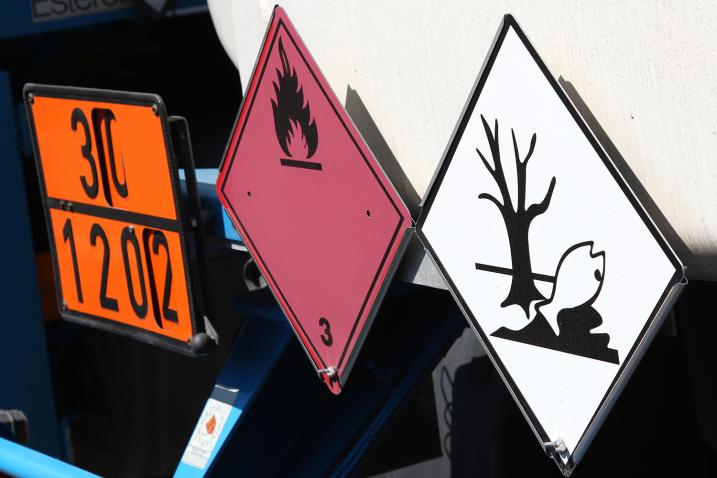Held in conjunction with the Working Party on Transport Trends and Economics (WP.5)
Programme of work: cluster F, inland transport security
Register now
I. INTRODUCTION
This workshop on Security Aspects of Dangerous Goods Transportation will be held by the secretariat as part of the 2021 UNECE Inland Transport Security Forum. It is designed to provide the Working Party on Transport Trends and Economics (WP.5) the opportunity to take stock of the security threats faced by the transport of dangerous goods sector and identify possible policies and approaches that can help to address these challenges most effectively.
II. BACKGROUND
A. Definitions
A dangerous good (also known as hazardous material or hazmat) is any substance or material that can pose an unreasonable risk to health, safety, and property. It may consist of pure chemicals, mixtures of substances, manufactured products or articles which can pose a risk to the safety and security of people, animals or the environment if not properly handled in use or in transport. Notable examples include compressed oxygen or other gases, explosives, flammable liquids including alcohol, petrol, and flammable solids (such as nitrocellulose) but also infectious substances, oxidizing substances (such as ammonium dichromate or pool chlorine as well as radioactive materials)1. Other examples include asbestos, automotive airbags, and lithium batteries.
Dangerous goods are subject to transport, workplace, storage, consumer, and environment protection regulations, to prevent accidents (safety and security issues) to persons, property, or the environment, to other goods or to the means of transport employed. To ensure consistency between all these regulatory systems, the United Nations has developed mechanisms for the harmonization of hazard classification criteria and communication tools, and for transport conditions for all modes for transport.
B. Regulatory framework
The transport of dangerous goods2 is governed by national and international regulations based on the United Nations Recommendations for the Transport of Dangerous Goods, Model Regulations. These Model Regulations are prepared by the Subcommittee of Experts on the Transport of Dangerous Goods of the United Nations Economic and Social Council (ECOSOC), which is serviced by UNECE. These Recommendations are updated every two years and implemented worldwide in modal regulations such as the European Agreement concerning the International Carriage of Dangerous Goods by Road (ADR) for road transport and the European Agreement concerning the International Carriage of Dangerous Goods by Inland Waterways (ADN) for inland waterways and the Regulation concerning the International Carriage of Dangerous Goods by Rail (RID) administered by the Intergovernmental Organisation for International Carriage by Rail (OTIF).
C. Safety and security risks
Transport of dangerous goods brings with it both safety and security risks. As referred to above, dangerous goods may include substances that are explosive, toxic, radioactive, corrosive, or flammable. In the event of a road or rail accident, spillage of these substances could cause hazards such as fire, damage to the environment, and chemical burns as well as injury to persons. In addition to these safety issues however, attention should also be paid to potential risks posed by the theft and misuse of the most hazardous goods by ill-intentioned individuals against people, property, the economy, or the environment. This category of hazardous goods is known as “high consequence dangerous goods” and are defined as those which have the potential for misuse in a terrorist event. As a result, of such misuse, severe consequences might ensue mass casualties, mass destruction or mass socio-economic disruption. Examples of high consequence dangerous goods include most explosives, specific toxic substances, infectious substances, and toxic gases as well as desensitized explosives, and radioactive material above a certain transport security threshold. Other substances and objects might also be considered high consequence dangerous goods depending on the mode of transportation, hazardous properties, packing group and quantities that are shipped3.
III. OBJECTIVES
With the above risks in mind, the workshop is expected to gather transport of dangerous goods safety and security experts from Ministries of Transport and other relevant, road, rail and inland waterway authorities as well as from private sector, academia, research institutions and independent experts engaged in this field from across the UNECE region and beyond.
It will provide a platform for participants to:
o Raise awareness about the security aspects of dangerous goods transportation.
o Exchange views, ideas, and experiences on how to identify, prevent and manage such security risks better.
o Identify next steps and possible UNECE contributions in better managing and regulating security aspects of the transport of hazardous substances.
IV. DRAFT PROGRAMME
15:00-15:10 – Welcoming Remarks
• Mrs. Els de Wit, Chair, Working Party on Transport Trends and Economics (WP.5), Netherlands
• Mr. Romain Hubert, Section Chief, Secretary of the Committee and Sub-Committee of Experts on the Transport of Dangerous Goods, Sustainable Transport Division, UNECE
15:10-15:40 – Session I – Setting the scene – Defining security aspects of dangerous goods transportation
Moderator: Mr. Claude Pfauvadel, Chair of RID/ADR/ADN Joint Meeting, France
• Mr. Jeffrey Muller, Senior Expert, Preventing and Responding to WMD/CBRN Terrorism Unit, United Nations Counter-Terrorism Centre (UNCTC)
• Ms. Sabrina Mansion, Scientific Affairs Officer, Sustainable Transport Division, UNECE
• Q&A
15:40-16:20 – Session II – How to better identify, prevent and manage transport of dangerous goods security risks?
Moderator: Mr. Claude Pfauvadel, Chair of RID/ADR/ADN Joint Meeting, France
• Mrs. Marie-Hélène Bonneau, Head, Security Division, International Union for Railways
• Mr. Luc Verriest, Inspector/ Expert, Federal Agency for Nuclear Control (FANC), Belgium
• Q&A
16:20-16:30 – Wrap up/ proposals for next steps
16:30 – End of workshop


